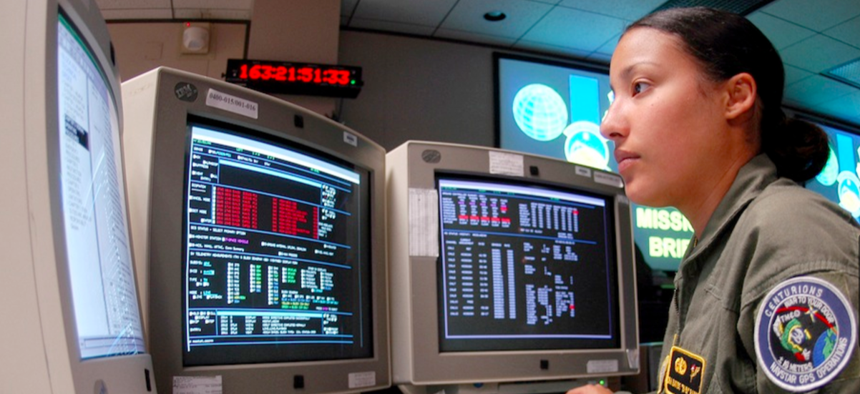
The GPS Operations Center at Schriever Air Force Base in Colorado Springs controls the GPS satellites. U.S. Air Force
Let the US Air Force Mature into the Space Force
Well-intentioned Congressional efforts to address problems risk trampling on existing solutions.
The “national security space structure is broken,” declared Rep. Mike Rogers (R-Alabama; no relation), whose proposal to create a U.S. Air Force “space corps” recently passed the House Armed Services Committee by a vote of 60-1. While I do broadly agree with the sentiments expressed by the congressman, I do not agree with his solution.
Rep. Rogers argued that the Pentagon’s space activities should not be led by officers and executive staff who “get up each morning thinking about fighters and bombers…you cannot organize, train, and equip in space the way you do a fighter squad.” Perhaps, a true statement. On a more bureaucratic level, he echoed a recent Government Accountability Office report that lamented “DOD’s culture has generally been resistant to changes in space acquisition approaches and that fragmented responsibilities have made it difficult to coordinate and deliver interdependent systems.” Here too I would not necessarily disagree. Both statement in and of themselves are worthy of action, but is wholesale, disruptive reform necessary?
If the Department of Defense and Air Force were idle, perhaps such sweeping legislatively driven reform would be necessary. If, however, we take a step back and look at the Air Force and the broader U.S. national security space architecture, we can see that the Pentagon in general, and the Air Force specifically, acknowledges these problems and is actively working to correct them.
First, Pentagon leaders recognize that space is a battlefield, not merely a support area. (This has, actually, been the state of affairs for some time, and certainly one our adversaries recognize. In 2013, China reportedly tested a missile that could reach geo-stationary orbit, where the U.S. military has some of its most sensitive early warning, communications, and global positioning satellites.)
“Space will be contested…it is now a warfighting domain,” read the bold-lettered written testimony submitted to the Senate’s Strategic Forces subcommittee by Air Force Secretary Heather Wilson; Chief of Staff Gen. David Goldfein; Space Command leader Gen. John “Jay” Raymond; and Lt. Gen. Samuel Greaves, who leads the Space and Missile Systems Center.
When I was the chairman of the House intelligence committee, I regularly received briefings on what our adversaries were doing in space — and how we members of the committee could help the Intelligence Community get the resources it needed to respond to and prepare for a dynamic space environment.
Second, this recognition is being translated into action. In June, Secretary Wilson, with whom I had the pleasure of working in Congress, announced the establishment of a Deputy Chief of Staff for Space Operations, a three-star Air Force post. The move will, in Sec. Wilson’s words, help “integrate, normalize, and elevate space” within the Air Force.
That followed last year’s release by Gen. John Hyten—then-commander of Air Force Space Command and now commander of U.S. Strategic Command—of his Space Enterprise Vision, which outlined how the Air Force should develop to meet new and evolving challenges in space. Key to this vision is increasing the United States’ “resilience capacity” to deliver services to America’s warfighters on the ground in a contested space environment. Gen. Hyten’s vision was embraced by Gen. Raymond and is now operationalized into the Space Warfighting Construct, which will change how we use today’s systems and guide the development of tomorrow’s to make them more diverse, flexible, survivable, and resilient.
Third, the Air Force is working hard to bring the same kind of training support to warfighters operating in space as is currently give to its highly capable fighter and bomber pilots. In April, the service held its first orbital version of the famed “Red Flag” wargame. “Space Flag will provide space operators mission planning experience and opportunities to apply tactics, techniques and procedures in response to a thinking adversary,” said 50th Space Wing Commander Col. Deanna Burt. Such exercises underline that space, rather than being merely an adjunct to traditional wargames, will be a central playing field. This effort must be expanded to include new simulations with realistic space aggressors. Failing to do so risks America losing its cutting edge in space.
Perhaps most notably, and in D.C. most importantly, the Air Force’s spending plans show its priorities. This year’s budget request asks to boost space funding by 20 percent, a not insignificant amount of money.
It is easy to forget that today’s Air Force grew out of an Army Air Corps that was allowed to mature in the crucible of World War II. It became independent when it was ready, not when it was forced to.
The reforms and policy initiatives currently underway will take time to implement, and much remains to be done. Legislative oversight is critical to their success, but legislating such a massive change risks undoing many of the reforms already enacted, interrupting efforts already underway, and undermining progress in the national security space architecture at a time when we as a nation can ill afford to do so.



